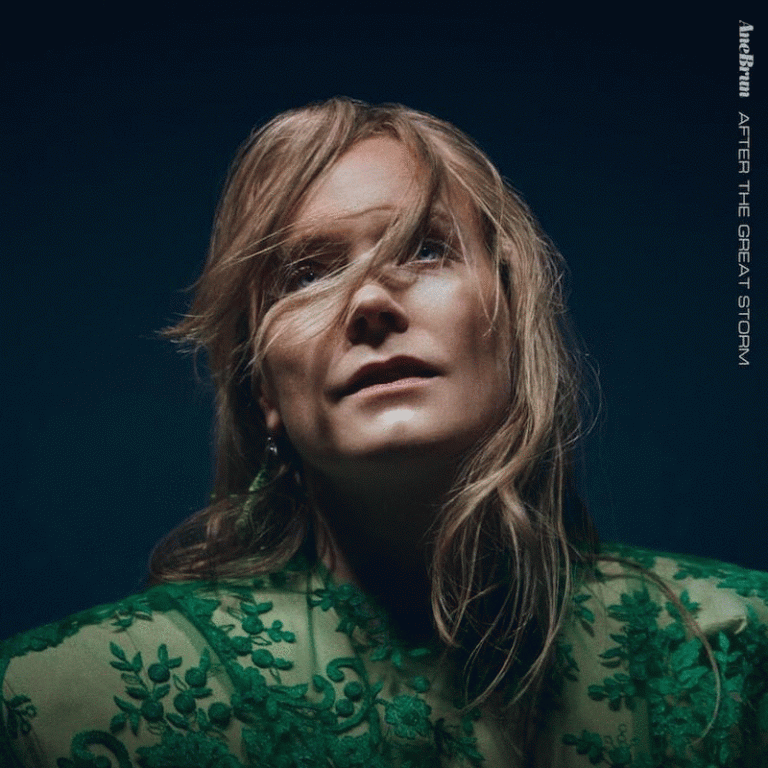The first words uttered on Ane Brun’s new album, After the Great Storm, are a simple count-in: “En, to, tre, fire” she says in her native Norwegian, voice masked with a dash of fuzz. It’s a deceptively old-fashioned and simple entrance into what may be the most dramatic gesture of Brun’s near-20-year career. After the Great Storm, you see, is only one of the albums Brun saw fit to release in the godforsaken year of 2020. It has a sister, the equally-dramatically-named How Beauty Holds the Hand of Sorrow, and while all but one of the collective 18 tracks were completed before the quarantine began, the decision to put out so much material in a year where people perhaps have more time to engage with it is a savvy and very welcome move.
The two albums — released about a month apart, After at the end of October, and How Beauty at the end of November — represent two very different sides of the songwriter. Known in the past mostly for her tender, delicate, and deeply emotive folk-oriented songs, Brun decided to push herself into slightly new territory this time around. The result of that mostly winds up on After the Great Storm, a heavily 90s-indebted album full of sparkling synths, swirling strings, groovy basslines, and thick percussion. Brun has cited acts like Massive Attack as a major point of influence, and while their inspiration is evident, so too are wisps of Portishead and Tricky, as well as 90s hip hop.
After that count-in, “Honey” kicks off After the Great Storm with a washing synth soundscape, a percussive gallop, and Brun’s instantly-recognizable voice. Hers is a unique instrument, capable of communicating so much passion without sacrificing subtlety or quietude; she is not a singer who requires bombast or volume. Her chilling vibrato — like a vibrating coo — and laser-like grace with pitch guide us through the nine songs on this album with ease, despite their extra layers.
Actually, Brun takes to this bigger production style quite smoothly. “Don’t Run and Hide” has a slow-motion dark alleys vibe, moonlit and mysterious. “Crumbs” has almost a hint of an 80s movie soundtrack glow with its insistent groove and warped choral vocals and organs. The title track has a slightly menacing keyboard riff percolating below her vocal, alongside a particularly lumbering drum beat.
Even though the stylistic shift from the majority of her older material to this is stark, it’s not like Brun is giving us nine fizzy, sugary, radio-friendly pop songs. These songs are still quite patient, often stretching past five minutes, settling on moody mantras and motifs, letting the instrumentals really lock into a zone and stay there. And Brun still finds space for some quieter moments, like the immaculate “Fingerprints” which sounds full of longing, with an almost Adele-adjacent melody. It’s one of the most cinematic tracks on the album.
The second album, How Beauty Holds the Hand of Sorrow, is much more familiar fare for Ane Brun fans. In fact, coming right after the first album, the piano that lulls us into the opening track, “Last Breath”, feels almost startling in its softness. This set of songs is much more organic, more acoustic, and more reliant on melody, emotive playing and singing, and the beauty of simplicity. Strings waft through, practically aching, as Brun sings pained lyrics like “I held your last breath / In my chest.” It’s decidedly less groovy and dusky than After the Great Storm, with Brun trading the noir for pure melancholic drama.
While this second album is sleepier and slower than its predecessor, there are still numerous highlights. “Closer” has one of Brun’s most striking melodies in a discography full of them, her voice unfurling alongside chilly piano keys and distant thudding percussion. “Meet You at the Delta” has Brun singing over her trusty acoustic guitar, redolent of older career highs like “Words” and “All We Want is Love”, her melody communicating deep loneliness and honesty. “Gentle Wind of Gratitude” is warm and hopeful, with one of the record’s few real drum beats. And “Lose My Way” features an astonishingly pretty arrangement from Dustin O’Halloran, of A Winged Victory for the Sullen, fitting right in with Brun’s gorgeous sound world.
How Beauty Holds the Hand of Sorrow ends with a piano version of “Don’t Run and Ride”, one of the bigger songs from After the Great Storm. It sounds like a demo, Brun alone at the piano, her voice and the keys reverberating into the space around them. It’s interesting to hear such a gentle reprise of the song, Brun proving that her voice and melodies don’t necessarily need all the dressing up to shine. Reprises are rarely integral to an album, and though this one arguably does fall into that same trap, its peek-behind-the-curtain energy provides a lovely, bittersweet end to the album.
Brun has such control of her craft, and that is made brightly plain across these two albums. Which one you prefer will likely depend on which genre or style you have deeper inclination for, but taken together, they’re both excellent representations of an artist honing her tested and true style while also venturing out into new waters, easily proving just how capable she is along the way.

